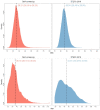A Report on Statistics of an Online Self-screening Platform for COVID-19 and Its Effectiveness in Iran
- PMID: 33619926
- PMCID: PMC9808172
- DOI: 10.34172/ijhpm.2020.252
A Report on Statistics of an Online Self-screening Platform for COVID-19 and Its Effectiveness in Iran
Abstract
Background: The most recent emerging infectious disease, coronavirus disease 2019 (COVID-19), is pandemic now. Iran is a country with community transmission of the disease. Telehealth tools have been proved to be useful in controlling public health disasters. We developed an online self-screening platform to offer a population-wide strategy to control the massive influx to medical centers.
Methods: We developed a platform operating based on given history by participants, including sex, age, weight, height, location, primary symptoms and signs, and high risk past medical histories. Based on a decision-making algorithm, participants were categorized into four levels of suspected cases, requiring diagnostic tests, supportive care, not suspected cases. We made comparisons with Iran STEPs (STEPwise approach to Surveillance) 2016 study and data from the Statistical Centre of Iran to assess population representativeness of data. Also, we made a comparison with officially confirmed cases to investigate the effectiveness of the platform. A multilevel mixed-effects Poisson regression was used to check the association of visiting platform and deaths caused by COVID-19.
Results: About 310 000 individuals participated in the online self-screening platform in 33 days. The majority of participants were in younger age groups, and males involved more. A significant number of participants were screened not to be suspected or needing supportive care, and only 10.4% of males and 12.0% of females had suspected results of COVID-19. The penetration of the platform was assessed to be acceptable. A correlation coefficient of 0.51 was calculated between suspected results and confirmed cases of the disease, expressing the platform's effectiveness.
Conclusion: Implementation of a proper online self-screening tool can mitigate population panic during wide-spread epidemics and relieve massive influx to medical centers. Also, an evidence-based education platform can help fighting infodemic. Noticeable utilization and verified effectiveness of such platform validate the potency of telehealth tools in controlling epidemics and pandemics.
Keywords: COVID-19; Epidemics; Iran; Public Health; Self-screening.
© 2022 The Author(s); Published by Kerman University of Medical Sciences This is an open-access article distributed under the terms of the Creative Commons Attribution License (http://creativecommons.org/licenses/by/4.0), which permits unrestricted use, distribution, and reproduction in any medium, provided the original work is properly cited.
Similar articles
-
Effectiveness and cost-effectiveness of four different strategies for SARS-CoV-2 surveillance in the general population (CoV-Surv Study): a structured summary of a study protocol for a cluster-randomised, two-factorial controlled trial.Trials. 2021 Jan 8;22(1):39. doi: 10.1186/s13063-020-04982-z. Trials. 2021. PMID: 33419461 Free PMC article.
-
SARS-CoV-2 antibody seroprevalence in the general population and high-risk occupational groups across 18 cities in Iran: a population-based cross-sectional study.Lancet Infect Dis. 2021 Apr;21(4):473-481. doi: 10.1016/S1473-3099(20)30858-6. Epub 2020 Dec 15. Lancet Infect Dis. 2021. PMID: 33338441 Free PMC article.
-
Quarantine alone or in combination with other public health measures to control COVID-19: a rapid review.Cochrane Database Syst Rev. 2020 Sep 15;9(9):CD013574. doi: 10.1002/14651858.CD013574.pub2. Cochrane Database Syst Rev. 2020. PMID: 33959956 Free PMC article.
-
Impact of Mass Screening on the Number of Confirmed Cases, Recovered Cases, and Deaths Due to COVID-19 in Iran: An Interrupted Time Series Analysis.Arch Iran Med. 2020 Nov 1;23(11):776-781. doi: 10.34172/aim.2020.103. Arch Iran Med. 2020. PMID: 33220696
-
Signs and symptoms to determine if a patient presenting in primary care or hospital outpatient settings has COVID-19.Cochrane Database Syst Rev. 2021 Feb 23;2(2):CD013665. doi: 10.1002/14651858.CD013665.pub2. Cochrane Database Syst Rev. 2021. Update in: Cochrane Database Syst Rev. 2022 May 20;5:CD013665. doi: 10.1002/14651858.CD013665.pub3. PMID: 33620086 Free PMC article. Updated.
Cited by
-
Patterns of case fatality and hospitalization duration among nearly 1 million hospitalized COVID-19 patients covered by Iran Health Insurance Organization (IHIO) over two years of pandemic: An analysis of associated factors.PLoS One. 2024 Feb 23;19(2):e0298604. doi: 10.1371/journal.pone.0298604. eCollection 2024. PLoS One. 2024. PMID: 38394118 Free PMC article.
-
'Inequalities in prevalence of hypertension, prehypertension, anti-hypertensive coverage, awareness, and effective treatment in 429 districts of Iran; a population-based STEPS 2016 small area spatial estimation model'.J Diabetes Metab Disord. 2023 May 22;22(2):1095-1103. doi: 10.1007/s40200-023-01186-5. eCollection 2023 Dec. J Diabetes Metab Disord. 2023. PMID: 37975079 Free PMC article.
-
A pilot study using financial transactions' spatial information to define high-risk neighborhoods and distribution pattern of COVID-19.Digit Health. 2022 Feb 9;8:20552076221076252. doi: 10.1177/20552076221076252. eCollection 2022 Jan-Dec. Digit Health. 2022. PMID: 35154804 Free PMC article.
-
Non-communicable diseases' risk factors in Iran; a review of the present status and action plans.J Diabetes Metab Disord. 2021 Jan 22;23(2):1-9. doi: 10.1007/s40200-020-00709-8. Online ahead of print. J Diabetes Metab Disord. 2021. PMID: 33500879 Free PMC article. Review.
-
Policy analysis of nutrition stewardship for prevention and control of Non-communicable diseases in Iran.BMC Health Serv Res. 2023 Jan 25;23(1):79. doi: 10.1186/s12913-023-09087-2. BMC Health Serv Res. 2023. PMID: 36694184 Free PMC article.
References
-
- Confirmed Cases and Deaths by Country, Territory, or Conveyance 2020; https://www.worldometers.info/coronavirus/. Accessed March 27, 2020.
MeSH terms
LinkOut - more resources
Full Text Sources
Other Literature Sources
Medical
Miscellaneous



